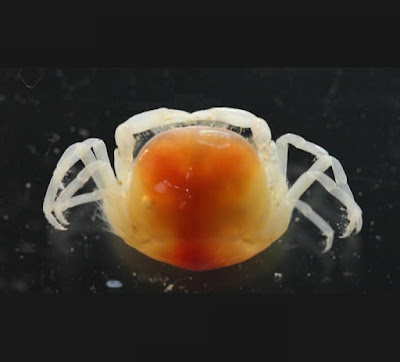[Most Recent Entries] [Calendar View]
Saturday, March 16th, 2019
| Time | Event | ||
| 7:25a | [Herpetology • 2019] Lynchius megacephalus • A Bizarre New Species of Lynchius (Anura, Strabomantidae) from the Andes of Ecuador and First Report of Lynchius parkeri in Ecuador
Abstract We describe a new species of Lynchius from the eastern montane forest of southern Ecuador. We also report the occurrence of L. parkeri in Ecuador, on paramos of Yacuri National Park, near the border with Peru. We used morphological and genetic evidence for the description of the new species and the new report of L. parkeri. Phylogenetic analyses were carried out using both maximum likelihood and Bayesian inference on DNA sequences for mitochondrial and nuclear genes. The phylogeny shows that L. simmonsi is sister to a clade composed of the remaining species of Lynchius and that the new species is sister to L. flavomaculatus. The new species has a prominent and heavily ossified head with noticeably spiculate cranial exostosis that easily distinguishes it from all its congeners. The dorsal region and limbs present several reduced subconical and rounded tubercles and pronounced dermal ridges on the dorsum. We also describe the osteology of the new species based on x-rays of the holotype. Only six species of Lynchius, two known to occur in Ecuador (L. flavomaculatus and L. simmonsi). The description of Lynchius megacephalus sp. nov. and new record of L. parkeri double the number of known Lynchius in Ecuador and suggest that the diversity of Ecuadorian and Peruvian Lynchius is still underestimated. Keywords: Systematics, osteology, morphology, co-ossified skull, natural history, Morona Santiago, new record, Amphibia Lynchius megacephalus sp. nov. Etymology. The name megacephalus is derived from the Greek mega meaning big and cephala meaning head. The name refers to the wide and robust head of this new species. The epithet is used as a noun in apposition. Distribution and Natural history. Lynchius megacephalus is only known from one specimen collected at the type locality in the Tinajillas-Río Gualaceño Ecological Conservation Area, Morona Santiago province, 2770 m of elevation. The holotype was collected during the night (approximately 22h00) on the forest floor, between leaflitter in the middle of a heavy rainy week. The ecosystem is Eastern Montane Forest (according to Ron et al. 2018 natural regions). The forest at the type locality is characterized by small streams and leaflitter> 10 cm thick ( Urgilés & Nieves 2014). The dense canopy can exceed 20 m height. The vegetation includes species of the genus Oreopanax, Weinmannia, Cinchona, Chusquea, and Baccharis (Baez et al. 2013). The new species was recorded in sympatry with Pristimantis versicolor, P. andinognomus, P. atratus, P. cryophilius, P. gualacenio, P. proserpens, P. spinosus, and an undescribed Lynchius species similar to L. flavomaculatus. Juan C. Sánchez-Nivicela, Veronica L. Urgiles, María José Navarrete, Mario H. Yánez-Muñoz and Santiago R. Ron. 2019. A Bizarre New Species of Lynchius (Amphibia, Anura, Strabomantidae) from the Andes of Ecuador and First Report of Lynchius parkeri in Ecuador. Zootaxa. 4567(1); 1–24. DOI: 10.11646/zootaxa.4567.1.1 twitter.com/JCSN_Herps/status/1106333746129702912 treatment.plazi.org/id/9B2EEC17FFF0964FF | ||
| 2:42p | [Crustacea • 2019] Pinnotheres bicristatus • A New Species of Pea Crab (Decapoda, Brachyura) from south-western Europe: Species Description, Geographic Distribution and Population Structure with An Identification Key to European Pinnotheridae
Abstract After the recent detection, by both morphology and DNA barcodes, of the larval stages of an unknown species of pea crab (Pinnotheres sp.) in European waters, adults of this crab are herein reported and described as a new species. The current known geographic distribution of the species comprises the Gulf of Cádiz in the eastern Atlantic and the adjacent Mediterranean waters of the south of the Iberian Peninsula (Alboran Sea), where this crab is well-established inside the anomiid bivalve Anomia ephippium. In the Gulf of Cádiz, the species displayed a relatively high prevalence: on average, 55.6–77.7%, in A. ephippium samples. The dominant demographic categories of the new species were soft females (61.8–77.0%) with fewer males (17.7–21.10%). Most of the host bivalves carried only one crab; in bivalves harbouring two crabs, heterosexual pairs were collected more frequently than expected by chance, which suggests that they could be mated pairs. A strong correlation between host size and soft female size was found (r = 0.73, P < 0.01) indicating that space availability within hosts seems to be relevant in determining the size of the sedentary phase of the new crab species. Keywords: Anomia ephippium; Brachyura; distribution; DNA barcoding; European waters; new species; Pinnotheres bicristatus Systematic Order DECAPODA Latreille, 1802 Infraorder BRACHYURA Latreille, 1802 Family PINNOTHERIDAE De Haan, 1833 Genus Pinnotheres Bosc, 1801 Pinnotheres bicristatus sp. nov. García Raso & Cuesta Etymology: The specific name bicristatus is an adjective (gender masculine as Pinnotheres) referring to the two ‘crests’ or dense tufts of setae located dorsoanterolaterally on the carapace of males and hard females. Jose A. Cuesta, J. E. García Raso, Pere Abelló, Elena Marco-Herrero, Luis Silva and Pilar Drake. 2019. A New Species of Pea Crab from south-western Europe (Crustacea, Decapoda, Brachyura): Species Description, Geographic Distribution and Population Structure with An Identification Key to European Pinnotheridae. Journal of the Marine Biological Association of the United Kingdom. First View. DOI: 10.1017/S0025315419000018 Descubierta una nueva especie de cangrejo guisante en aguas andaluzas bit.ly/2TDsAeE @ICMAN_CSIC @CSICAndalExtrem |
| << Previous Day |
2019/03/16 [Calendar] |
Next Day >> |




